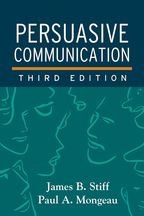Persuasive Communication
Third Edition
James B. Stiff and Paul A. Mongeau
A Paperback Originale-bookprint + e-book
A Paperback Original
orderAugust 22, 2016
ISBN 9781462526840
Price: $72.00 383 Pages
Size: 6" x 9"
“A good choice for a textbook for a persuasion class....This book would be good for graduate students, and especially for graduate students who already have a foundation in quantitative methods.”

—Journalism and Mass Communication Quarterly (on the second edition)
“Stiff and Mongeau present another masterful synthesis of persuasion research. The chronological framework provides historical context and enables the reader to clearly see the point–counterpoint that defines the development of scientific knowledge. In the third edition, crisp new examples, both classic and contemporary, vivify the writing and illustrate just how consequential persuasion is in the sciences, politics, health, and the law. This is an ideal stand-alone textbook for an undergraduate class that seeks to show what is known about persuasion and how we have come to know it. The succinct coverage of multiple research traditions makes the book equally valuable as base reading for a graduate class.”

—James Price Dillard, PhD, Department of Communication Arts and Sciences, The Pennsylvania State University
“This revised third edition maintains the readability of the second edition while completely updating the research. It is an absolutely wonderful text. The presentation of most material is accomplished by pairing seminal studies—including accessible descriptions of research designs—with state-of-the-art, modern scholarship that indicates the trajectory of knowledge in each area. Like the prior editions, both of which I used in my classes, this is the perfect text for upper-division undergraduate or early graduate students in communication.”

—Mary Lynn Miller Henningsen, PhD, Department of Communication, Northern Illinois University
“The content and organization of this book are ideal, and entirely in line with how I study and teach persuasion. The chapters on attitudes causing behaviors and behaviors causing attitudes are excellent; I know of no other texts that make this distinction, and it is an important one. I very much like the topic boxes in the third edition, which highlight major points like the use of order effects in jury consultation.”

—Thomas Feeley, PhD, Department of Communication, University at Buffalo, The State University of New York
“I enjoyed the extensive discussion of the different psychological factors that underlie persuasive communication; mass communication majors will benefit from understanding these processes. The book not only provides a clear discussion of the factors that influence persuasion, but also goes into methodological aspects and does not shy away from current and past controversies in the field. The authors do an excellent job of teasing apart different concepts and explaining how they are related to each other and persuasion in general.”

—Judith E. Rosenbaum, PhD, Mass Communication Program, Albany State University, Georgia
“I strongly recommend this book as a mid-level undergraduate text and general reference. It is very readable, with good examples.”

—Kathryn Greene, PhD, School of Communication and Information, Rutgers, The State University of New Jersey
—Journalism and Mass Communication Quarterly (on the second edition)
“Stiff and Mongeau present another masterful synthesis of persuasion research. The chronological framework provides historical context and enables the reader to clearly see the point–counterpoint that defines the development of scientific knowledge. In the third edition, crisp new examples, both classic and contemporary, vivify the writing and illustrate just how consequential persuasion is in the sciences, politics, health, and the law. This is an ideal stand-alone textbook for an undergraduate class that seeks to show what is known about persuasion and how we have come to know it. The succinct coverage of multiple research traditions makes the book equally valuable as base reading for a graduate class.”
—James Price Dillard, PhD, Department of Communication Arts and Sciences, The Pennsylvania State University
“This revised third edition maintains the readability of the second edition while completely updating the research. It is an absolutely wonderful text. The presentation of most material is accomplished by pairing seminal studies—including accessible descriptions of research designs—with state-of-the-art, modern scholarship that indicates the trajectory of knowledge in each area. Like the prior editions, both of which I used in my classes, this is the perfect text for upper-division undergraduate or early graduate students in communication.”
—Mary Lynn Miller Henningsen, PhD, Department of Communication, Northern Illinois University
“The content and organization of this book are ideal, and entirely in line with how I study and teach persuasion. The chapters on attitudes causing behaviors and behaviors causing attitudes are excellent; I know of no other texts that make this distinction, and it is an important one. I very much like the topic boxes in the third edition, which highlight major points like the use of order effects in jury consultation.”
—Thomas Feeley, PhD, Department of Communication, University at Buffalo, The State University of New York
“I enjoyed the extensive discussion of the different psychological factors that underlie persuasive communication; mass communication majors will benefit from understanding these processes. The book not only provides a clear discussion of the factors that influence persuasion, but also goes into methodological aspects and does not shy away from current and past controversies in the field. The authors do an excellent job of teasing apart different concepts and explaining how they are related to each other and persuasion in general.”
—Judith E. Rosenbaum, PhD, Mass Communication Program, Albany State University, Georgia
“I strongly recommend this book as a mid-level undergraduate text and general reference. It is very readable, with good examples.”
—Kathryn Greene, PhD, School of Communication and Information, Rutgers, The State University of New Jersey



